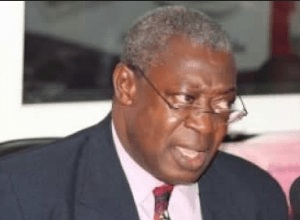Prof Akosa advocates second stream medical students

Professor Agyeman Badu Akosa, Executive Director of Healthy Ghana, has advocated the need for the training of a second stream of medical students by the Korle Bu and the Komfo Anokye Teaching Hospitals.
According to him the proposal would enable the nation to close the gap of doctor – patient ratio of one is to 10,000, to one is to 5,000; to help meet the growing health needs of the populace.
“Ghana as a middle income country should have one doctor to 5,000 patients but we are still have one doctor to 10,000.
“Our population growth is phenomenal and therefore, no matter what you do, you need a catch up,” he said.
Prof Akosa was speaking in Accra during a panel discussion on the topic “Capacity Enhancement for Health Care Professionals: The Role of ICT” at the 67th New Year School and Conference on the theme “Promoting Universal Health for Sustainable Development in Ghana: Is the Information, Communication and Technology the Game Changer”.
“My idea is that you know at independence there were few schools but the policy decision was that school should be compulsory; so every child should go to school.
“How else could we have done it? Other than to say that four hours of schooling per child is better than none for a lot of people.
“So of course there was a shift system. And we all went through. You go in the morning, some people come in the afternoon.
“Today people talk about it as if it was a bad policy, but at that time with limited infrastructure that is what they have to do,” he said.
He said despite the limited infrastructure at the nation’s two leading medical schools; the whole idea of the proposal is that every region has got regional hospital; which must have an establishment of specialists and consultants who could teach undergraduate medical school.
He explained that therefore, the country could use all the regional hospitals in the clinical training of the second stream of medical doctors.
Prof Akosa said:“This country needs to triple and quadruple the production of medical doctors.”
He observed that although the University of Cape Coast and the University for Development Studies Medical Schools are struggling, however, they are producing medical doctors.
“Today we see the establishment of private medical schools, may be that might be the solution.
“But I think that the public institutions must jack up the numbers of doctors being trained. Today is about 200, but I am saying 200 is woefully inadequate,” he said.
He noted that: “Malaysia in 2010 had a doctor to patient ratio of one to 1,700, the country took a decision that they want the Europe ratio of one to 300.
“And therefore, by December 2015, they were working to achieve one is to 300; and they have achieved it.
“This the country determined to make sure that healthcare provision is good, there is equality or there is equity distribution. And they have done it.”
Prof Akosa said: “We have not even today proposed that we are going to achieve one in 5,000 and we are still one in 10,000. And somehow we think we are doing well? We are not.”
“So primary production, and how can you do it? I am saying you immediately create production house. In every lecture room there must be recording facilities. You record the lecture and you can beam to the second stream.
“This is distance learning but almost in an anteroom where instantly they are receiving the lectures on technological application,” he added.
Prof Akosa, who is a former Director-General of the Ghana Health Service and also a former President of the Ghana Medical Association, advocated continuous training especially using ICT at seminars and workshops for doctors and other medical staff to enhance their efficiency and performances.
He said it is better for every doctor to be in a continuous state of training and learning, stating that “if you read every day, you are better doctor everyday”.
On the primary production of healthcare professionals, Prof Akosa observed that the nation is running between 10 to 30 per cent capacity; affirming that “in other words we should by now be tripling our production of healthcare professionals in this country”.
“Sadly even those that are being produce within the 10 to 30 per cent capacity are not being employed.
“So we have a bottleneck and yet we have almost inadequate professional capacity within our systems,” he said.
Source: GNA
